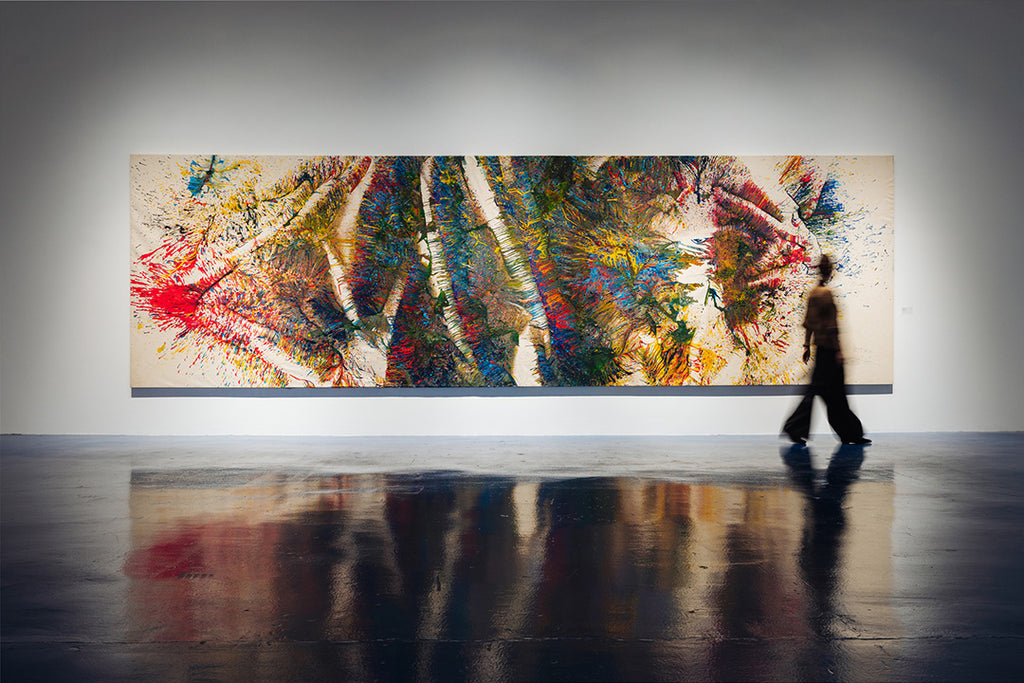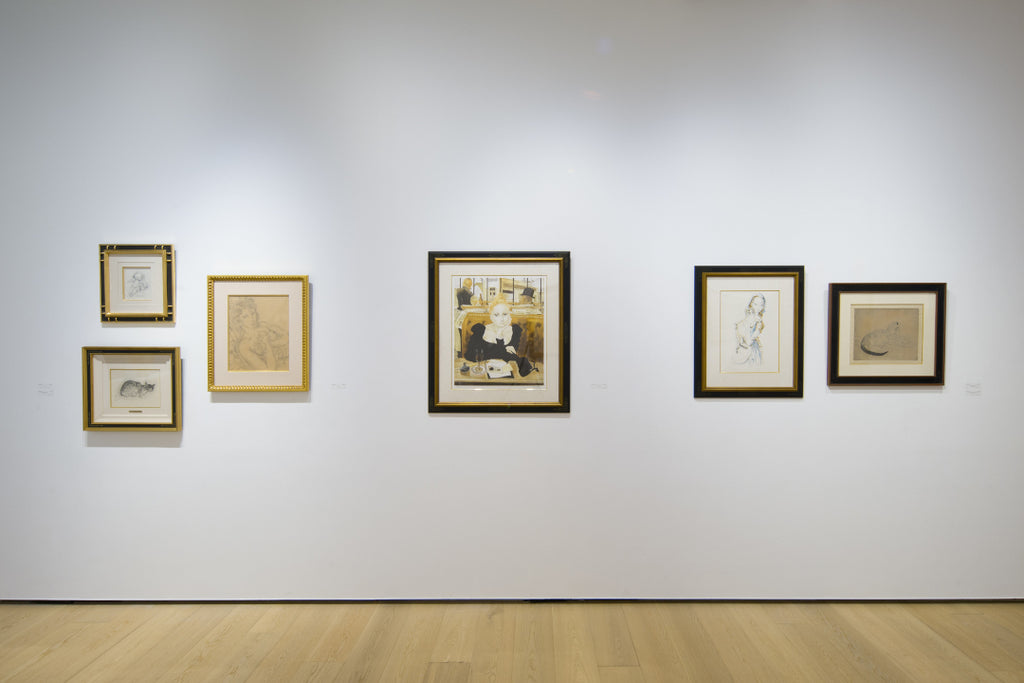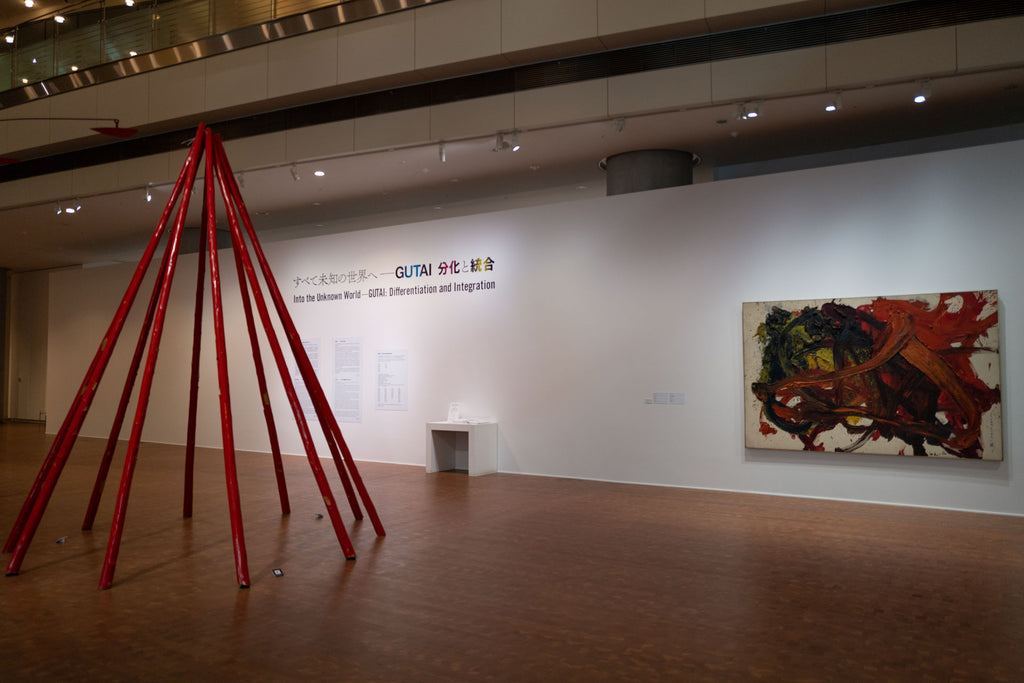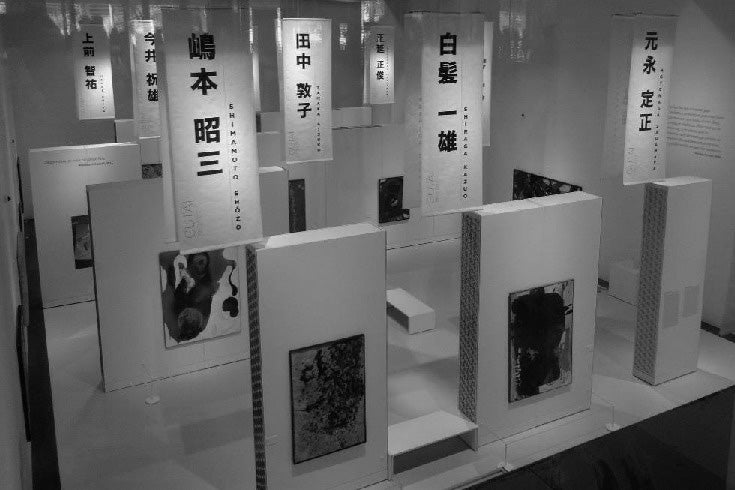ARTICLES
Interview with Yuko Nasaka: The Infinite Possibilities of Circles
GUTAI STILL ALIVE 2015 vol.1
16/35

A project evolving the digitized archive of the book, “GUTAI STILL ALIVE 2015 vol.1”. The 16th edition features a dialogue between 2nd-generation Gutai Artist Yuko Nasaka and art historian Kunio Motoe. They talk about her use of circles as a motif in her works and her thoughts about creating art in her later years.
Enthusiasm and Fun: The Spirit of Gutai
An Interview of YUKO NASAKA by Kunio Motoe
The Gutai group was founded by Jiro Yoshihara in 1954. The member artists’ unique activities under the strong leadership of Yoshihara lasted 18 years until the group’s disbandment in 1972, and drew international attention as Japan’s avant-garde art movement. Kunio Motoe, professor at Tama Art University, asks Yuko Nasaka, a second-generation Gutai artist recently spotlighted anew, about her years of enthusiasm and fun in Gutai.
Ashiya city art exhibition and Jiro Yoshihara
Motoe: You are a member of “Gutai.” Did you have any experience in drawing or whatever in an art club?
Nasaka: In high school I belonged to an art club and made drawings and paintings among my fellows who were drawing buildings or people. But I realized that I wasn’t suited for such things.
Motoe: What did you want to be, at the beginning?
Nasaka: A graphic designer, I was thinking vaguely. When in high school I was asked to help paint a backdrop for a theater club of another high school. But I declined, saying, “I’m going to be a painter. So I won’t do such a thing!” ... Actually I just didn’t have stamina to paint such a large work (laughter).
Motoe: Then you graduated from college, started exhibiting at Ashiya city art exhibitions and were appreciated by JiroYoshihara. You also won a mayor’s award. I heard that it was not so easy to enter the Gutai group at that time. How about you?
Nasaka: Actually it wasn’t that difficult for me. Also, I don’t remember Yoshihara ever scolded me. I had no idea at all who he was when I was exhibiting at Ashiya city art exhibitions.
Motoe: I think that’s a rare case. Yoshihara was known to be a strict person. And you would hold a solo exhibition at Gutai Pinacotheca*. At that time no one else responded to Yoshihara’s bid to exhibit there, and he named you at last, I heard.
Nasaka: That’s right. A couple of times he asked if any of us wanted to do a solo exhibition, but all remained silent. Then he called me and I ended up saying, “Yes.”
Motoe: Was the exhibition space in Gutai Pinacotheca large?
Nasaka: Yes. I could exhibit a painting measuring 294 x 620 centimeters and two other paintings of different style, and sculptures. The space was really large. I showed everything I could at that time. Many artists came from overseas. Sam Francis, Robert Rauschenberg, Paul Jenkins, John Cage and members of Merce Cunningham Dance Company visited my solo exhibition.
Motoe: Such great people! You were happy, weren’t you?
Nasaka: Yes, I was in my 20s at that time. I was really happy.
Motoe: “Gutai” exhibitions were held every month, right? Did you suffer any disadvantages for being a woman?
Nasaka: You need considerable energy to exhibit every month. Atsuko Tanaka, Tsuruko Yamazaki and Kimiko Ohara were among the woman artists at that time, but whether we could exhibit or not depended on the works. It was a short time, but a time of enthusiasm. I worked every day until very late at night, and did my best.
Motoe: Then what was “Gutai,” with which you experienced enthusiasm and fun, to you?
Nasaka: A truly luxurious place in which I spent a really great time. I met great people and works. Mr. Yoshihara died suddenly and the Gutai group was disbanded in sorrow. A long time has passed since then, but every Gutai member is still active. The group gave us such amazing spirit and vigor. I’m thankful to everyone.
“Circle” and its infinite possibilities
Motoe: We associate Yoshihara with “circles.” But you too are known for your “circles.” I kind of feel that you were first ... .
Nasaka: Indeed we both are artists of “circles” (laughter). I was just doing it in my own way, different from Mr. Yoshihara’s style.
Motoe: Why did you take up “circles”?
Nasaka: I wonder why too. My father ran a factory of meters. I used to see round manometers or thermometers there. I guess such surroundings had something to do with that.
Motoe: As you produced works, you stuck to “circles” even more. Why?
Nasaka: From the point at which I drew “circles,” I could do various things, create various works. I realized great possibilities.
Motoe: If you draw a “circle,” it will become a work of art. A “circle” is an absolute form, it means.
Nasaka: That’s right. But I wasn’t thinking that big (laughter).
Motoe: Oh, you are great. Like Seurat and Signac invented pointillism in the end of the 19th century. This might sound a bit formal, but if someone asks how a sheet of paper becomes a work of art, you have answered, “You only have to draw a circle.” It’s a great thing. “Circles” can be drawn by anyone, with or without tools. This certainly leads to “Gutai.” By the way, you don’t put titles to your works.
Nasaka: Once I used to put numbers to my works. But I never put titles. Each work has its own, vast possibilities, I believe.
Motoe: But those who have bought your works might be embarrassed.
Nasaka: Yes. Once someone who was to buy my work asked me about the title and content of the work. I said, “You can see and imagine, as you like.” When one work was to be installed in a facility of the city of Ibaraki, city officials insisted that it should have a title. So I put one. Once I put a title to a work, the work gets defined by the title. I don’t like it ... .
Motoe: Speaking of titles, I remember one work titled “Work.”
Nasaka: Atsuko used “work” for titles, so I kind of followed her. I call smaller works “pieces.” A work is a work, anyway.
Motoe: I see. Even if a work doesn’t have a title, it doesn’t mean that it’s blank.
Nasaka: I sometimes wonder what to do from now. I try “Infinity” or “Space Representation” as titles, but “Infinity” sounds somewhat presumptuous and exaggerated ... .
Motoe: Certainly “Infinity” might be an exaggeration. “Space Representation” might fit a large work, but not a small-size work. Putting a title to a work is not just selection of a word. It’s a more essential thing, I think. That’s why you hate being asked about the method or material of your works, I guess.
Nasaka: The method and material are the way of expression peculiar to the artist. Telling everything about such things is boring. I only wish you to see my works. Am I selfish?
Motoe: What is a “good work” for you?
Nasaka: While I’m making a work, if I feel, “This looks OK,” it becomes a “good work.” Otherwise, I would peel the surface off the work. But peeling the surface off a large work requires great energy. It’s really hard ... . I have thrown away a considerable number of large works. Partly because of the illness of my husband, I haven’t kept records of myself.
Motoe: It’s regrettable, but the Japanese are animists so we can throw away things easily, unlike people in the stone culture. To be able to throw away things means you can do things anew. It’s nice.
Nasaka: I’m 76 and sometimes I feel it hard to go out. I don’t know what I’m going to be.
Motoe: Some people might think so, but that’s not right. You can do and must do something. That’s the way an artist is rewarded.
Making works again for a solo show
Motoe: You ceased producing works in 1993. But now you are preparing for a solo show for the first time in a long time. What made you decide to produce works again?
Nasaka: I ceased producing works for various reasons, but other Gutai artists continue working independently and wonderfully. So I reconsidered.
Motoe: Have you decided what to show?
Nasaka: Not yet actually. Not many new works have been finished ... . It took much time to make up my mind to produce works again.
Motoe: It has been a long pause, so it might be difficult to come back to good condition. (Looking around the atelier) oh, there are many works here. (Picking up one) this is good, isn’t it?
Nasaka: That’s nearly all I can do at the moment. I wonder whether I should do more or stop here. I tend to do things thoroughly. I feel I’m recovering slowly, so I’m enjoying making works.
Motoe: It’s really good to enjoy working. I’m happy to hear that you are “enjoying” working, many times. I look forward to visiting your show.
Nasaka: I think it’s a shame to repeat making works that I made in the past. I’ll do my best anyway.
(Gekkan Bijutsu, September 2014)
Read more about the “Gutai Art Association »
*Information in this article is at the time of publication.



